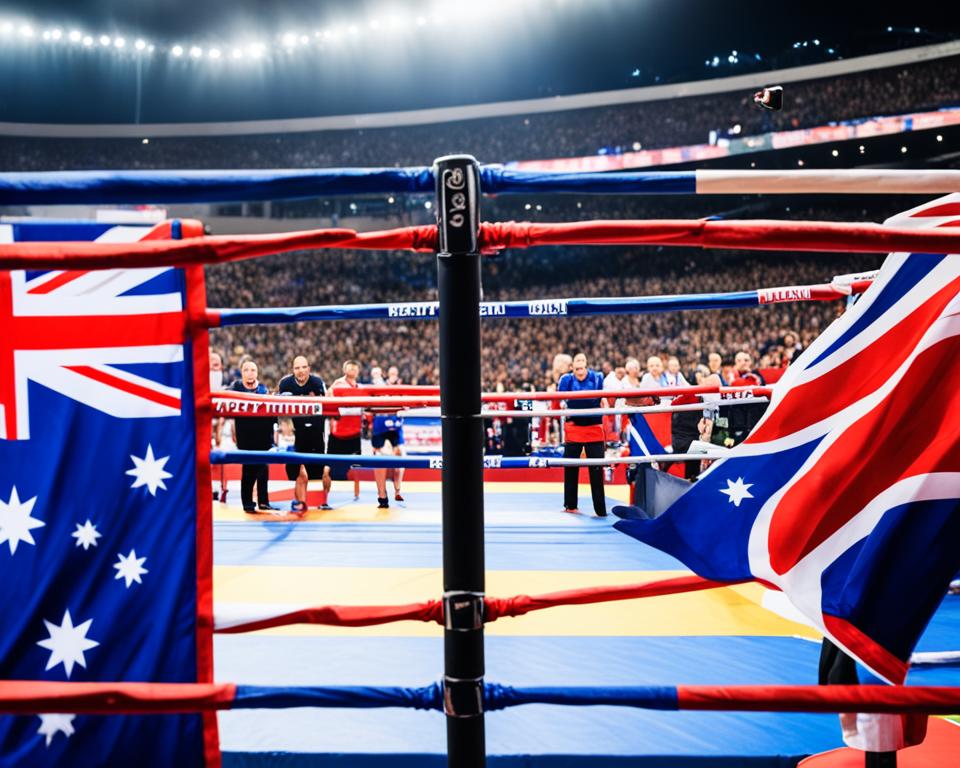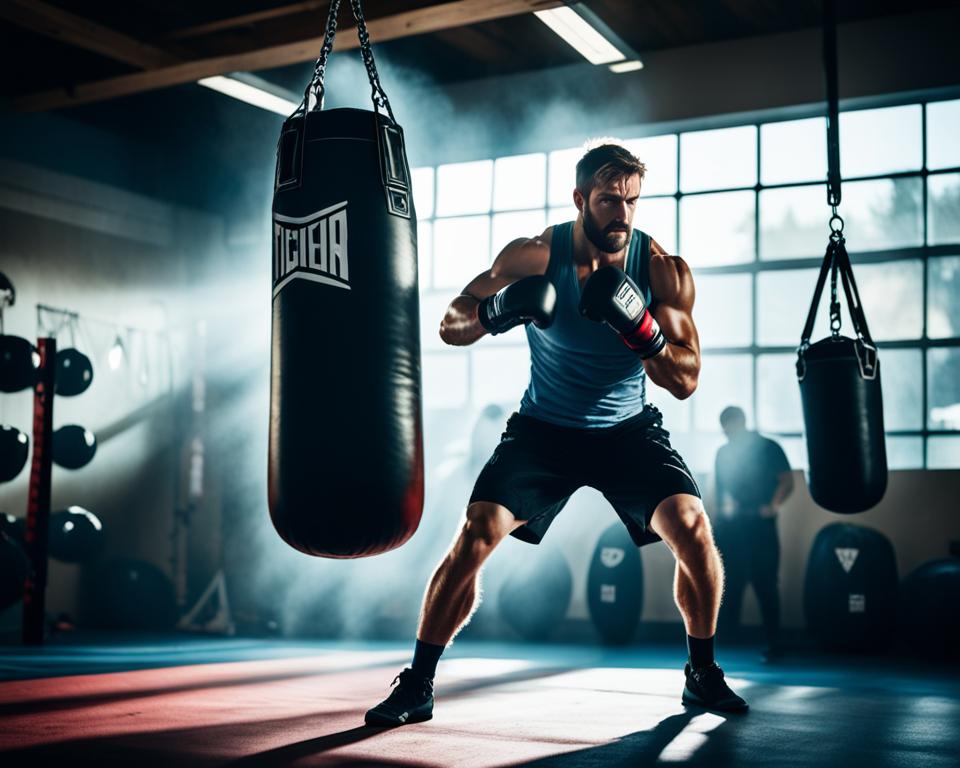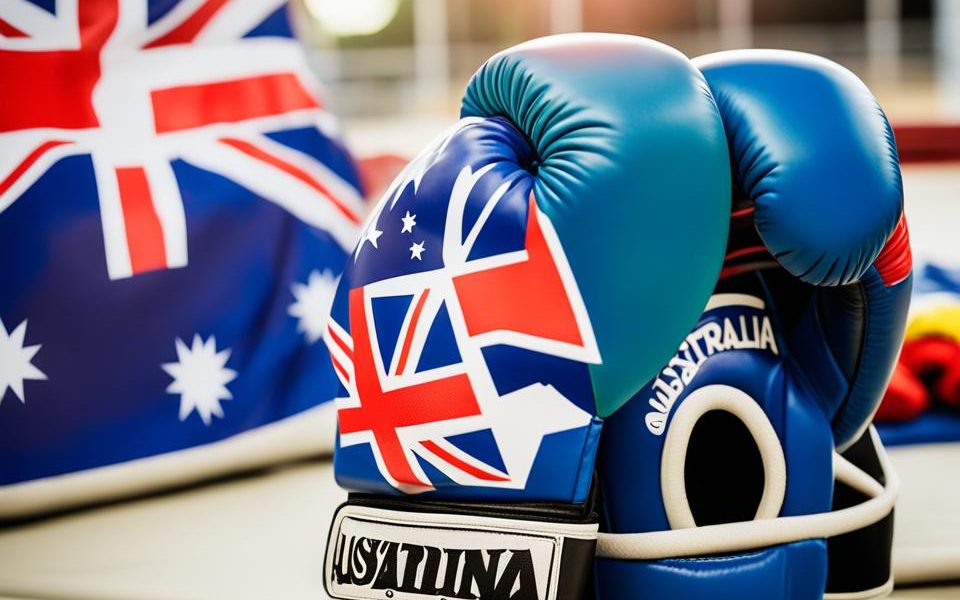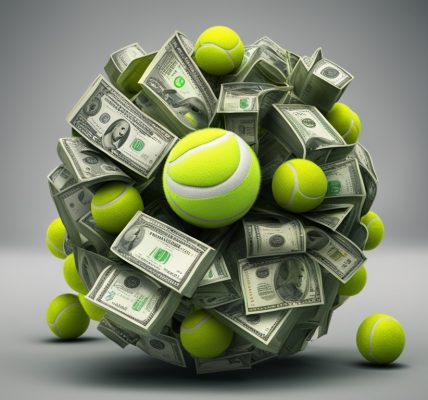Muay Thai is a martial art and the national sport of Thailand. It’s now popular in Australia too. This sport is both dynamic and demanding. It needs clear rules for safety and fair play.
This guide covers the key rules and regulations of Muay Thai in Australia. It goes from the sport’s history to the groups that run competitions here. It’s useful for anyone interested in Muay Thai, whether you’re a pro, want to compete, or just love the sport.
Read more interesting information at ::ds-collection
Understanding Muay Thai’s Origins and Significance
Muay Thai, a martial art from Thailand, has a long history. It started as a way for warriors to fight and has become a popular sport. Learning about its origins and cultural importance helps us understand its lasting impact.
The Ancient Roots of Muay Thai
Since the 16th century, Thai warriors used Muay Thai to defend their kingdom. It was a fighting skill that included fists, elbows, knees, and shins. Over time, it grew into a unique martial art with its own techniques and values.
Muay Thai’s Rise as a National Sport in Thailand
In the late 19th century, Muay Thai became a beloved national sport. It got its own rules, training camps, and famous fighters. Now, it’s a symbol of national pride, loved by people all over the world.
“Muay Thai is not just a fighting technique; it is a way of life that embodies the spirit and resilience of the Thai people.”
Muay Thai is a respected martial art, closely linked to Thailand’s identity and history. Its global popularity shows how much it’s valued. Those who practice it work to keep its traditions and values alive.
Governing Bodies and Regulations in Australia
In Australia, Muay Thai has a strong set of rules and bodies that keep the sport safe and fair. These groups make sure australian muay thai rules and muay thai legal guidelines australia are followed. They help muay thai governing bodies australia work well.
The main group in charge of Muay Thai is the Australian Muay Thai Association (AMTA). They set the rules for fights and train coaches and referees. They also make sure fighters are safe and ready to compete.
- The AMTA checks Muay Thai events and makes sure fighters are licensed and safe.
- They work with local groups to keep rules the same everywhere in Australia.
The Australian National Boxing Federation (ANBF) also plays a big role. Even though they focus on boxing, they also look after Muay Thai fights. This is especially true for fights with professional fighters.
| Governing Body | Primary Responsibilities |
|---|---|
| Australian Muay Thai Association (AMTA) | – Making and enforcing Muay Thai rules – Approving fights and licensing fighters – Working with local groups |
| Australian National Boxing Federation (ANBF) | – Looking after professional Muay Thai fights – Making sure fighters are safe and healthy |
These groups work together to make sure Muay Thai in Australia is safe and growing. They focus on the safety and health of everyone involved.
Muay Thai Australia Rules: Key Principles and Techniques
Muay Thai, known as the “Art of Eight Limbs,” is a dynamic combat sport loved in Australia. It’s all about key principles and techniques that make it unique. For those in Australia wanting to get better at Muay Thai, knowing these basics is key.
The Eight Limbs of Muay Thai
Muay Thai is famous for its “eight limbs” – punches, kicks, knees, and elbows. This makes it different from other sports, as fighters need to use all eight points of contact well. Techniques like the powerful straight punch and the roundhouse kick are vital.
Striking Techniques: Punches, Kicks, and Elbow Strikes
In muay thai australia rules, mastering striking is crucial. Fighters work on skills like the jab, cross, and roundhouse kick. The elbow strike is also a key move, delivering strong blows when done right.
To get good at these, fighters need to work on their fitness, strategy, and know the australian muay thai rules and muay thai regulations. Those in Australia aiming for Muay Thai must train hard, improve their skills, and compete with respect for the art’s traditions.
| Muay Thai Striking Techniques | Description |
|---|---|
| Punches | Jab, Cross, Hook, Uppercut |
| Kicks | Roundhouse Kick, Front Kick, Teep |
| Elbow Strikes | Horizontal Elbow, Vertical Elbow, Flying Elbow |
“Muay Thai is not just a sport; it’s a way of life. The principles and techniques we learn on the mat translate to the way we conduct ourselves in all aspects of our lives.”
Ring Dimensions and Equipment Requirements
When it comes to muay thai competition rules australia, the ring’s size and build are key. The australian muay thai association rules require a standard-sized boxing ring. It should be 20 to 24 feet wide. The ring must be raised, 2 to 4 feet off the ground, for everyone’s safety and viewing pleasure.
The ring’s floor is covered with a strong, shock-absorbing material like canvas. It’s attached to a sturdy frame. The ropes around the ring must be at least four in number. The bottom rope is 18 inches from the ground, and the top rope is 52 inches up. These ropes are made of tough materials to keep fighters safe.
| Ring Dimension | Requirement |
|---|---|
| Diameter | 20 to 24 feet |
| Elevation | 2 to 4 feet |
| Rope Number | Minimum of 4 |
| Bottom Rope Height | 18 inches from the floor |
| Top Rope Height | 52 inches from the floor |
Also, muay thai competition rules australia and australian muay thai association rules require certain safety gear. Fighters must wear gloves, shin guards, and groin protectors. This gear helps reduce the risk of getting hurt during the fight.
Weight Categories and Fighter Classifications
In the exciting world of muay thai competitions australia, weight categories are key. They make sure fights are fair and safe. Fighters of similar size and weight compete, making the game more balanced and safer.
The professional muay thai rules australia set up different weight classes. These range from the lightest flyweight to the biggest heavyweight. Each class has a weight range. This lets fighters plan their weight and face opponents of similar size and strength.
- Flyweight: Up to 112 lbs (50.8 kg)
- Bantamweight: 115 lbs (52.2 kg) to 118 lbs (53.5 kg)
- Featherweight: 126 lbs (57.2 kg) to 130 lbs (59.0 kg)
- Lightweight: 135 lbs (61.2 kg) to 140 lbs (63.5 kg)
- Welterweight: 147 lbs (66.7 kg) to 154 lbs (69.9 kg)
- Middleweight: 160 lbs (72.6 kg) to 168 lbs (76.2 kg)
- Light Heavyweight: 175 lbs (79.4 kg) to 181 lbs (82.1 kg)
- Heavyweight: 190 lbs (86.2 kg) and above
For muay thai fighters, managing their weight is crucial. They must weigh in before fights to fit their class. This keeps the sport fair and protects the fighters’ health.
Following these weight rules and fighter classes, muay thai competitions australia and professional muay thai rules australia focus on fairness, safety, and sportsmanship. These are key values of this dynamic martial art.
Scoring and Judging Criteria
In Australia, Muay Thai competitions use a scoring system and criteria to pick winners. The Australian Muay Thai Association sets these rules for fair and clear fighter evaluation.
The Scoring System Explained
Judges score Muay Thai matches. They look at fighters’ techniques, how well they work, and who’s in charge during the rounds. The scoring is a 10-point must system. The winner of each round gets 10 points. The loser gets 7 to 9 points based on their performance.
When scoring a round, judges look at these things:
- Effective striking: Successful use of punches, kicks, knees, and elbows
- Defensive maneuvers: Good blocking, dodging, and avoiding moves
- Aggression and ring control: Setting the fight’s pace and controlling it
- Sportsmanship and adherence to rules: Following Muay Thai rules and showing respect
| Criteria | Description | Score |
|---|---|---|
| Effective Striking | Successful use of all eight limbs (punches, kicks, knees, and elbows) | 4 points |
| Defensive Ability | Good blocking, dodging, and avoiding moves | 3 points |
| Aggression and Ring Control | Setting the fight’s pace and controlling it | 2 points |
| Sportsmanship | Following the rules and showing respect for Muay Thai | 1 point |
The fighter with the most points at the end wins. If there’s a tie, they might have a sudden death or extra round to decide.

“The scoring system in Muay Thai is designed to reward fighters who demonstrate a mastery of the eight limbs, as well as strategic command of the ring and respect for the sport’s traditions.”
Safety Protocols and Medical Requirements
In the world of Muay Thai, keeping fighters safe is key. The australian muay thai rules have strict safety rules and medical checks. These rules help protect players and manage injuries well.
Before fighting in Muay Thai in Australia, fighters must pass a detailed health check. This check looks at their overall health and checks for any health issues that could be a risk during the fight. Muay thai legal guidelines australia say that doctors and trainers must be there at all fights. They are ready to help if someone gets hurt.
- Pre-fight medical examinations to check if fighters are fit and look for health risks
- Doctors and trainers must be at all Muay Thai events to help
- Rules for handling injuries to make sure fighters get the right care fast
- Insurance to cover Muay Thai fighters if they get hurt or have an accident
The rules for Muay Thai in Australia show how much they care about the fighters’ health. With these muay thai legal guidelines australia, fighters can train and compete safely. They know their health and safety are the main focus.
| Medical Requirement | Details |
|---|---|
| Pre-fight Physical Examination | Comprehensive check of fighter’s health to spot any risks |
| On-site Medical Personnel | Licensed doctors, trainers, and emergency staff at all Muay Thai events |
| Injury Management Protocols | Steps to treat fighters quickly if they get hurt during a fight |
| Insurance Coverage | Insurance to protect Muay Thai fighters if they get hurt or have an accident |
“The safety of our fighters is our top priority. We have implemented stringent protocols to ensure their well-being and provide them with the best possible care during Muay Thai events.”
Muay Thai Competitions and Events in Australia
Australia has a strong Muay Thai scene with many competitions and events all year. These big tournaments let top Muay Thai athletes show off their skills and compete for top titles.
Notable Australian Muay Thai Organizations
The Australian Muay Thai Association (AMTA) is a top group for Muay Thai in Australia. They run big events like the Australian Muay Thai Championships, drawing fighters from all over. The World Muay Thai Council Australia (WMC Australia) also hosts big events, like the WMC Australia National Championships.
Groups like the Victorian Muay Thai Association (VMA) and the New South Wales Muay Thai Association (NSWMA) offer chances for Muay Thai fighters to compete in their states.
| Organization | Major Events | Locations |
|---|---|---|
| Australian Muay Thai Association (AMTA) | Australian Muay Thai Championships | Across Australia |
| World Muay Thai Council Australia (WMC Australia) | WMC Australia National Championships | Across Australia |
| Victorian Muay Thai Association (VMA) | Victorian Muay Thai Championships | Victoria |
| New South Wales Muay Thai Association (NSWMA) | NSW Muay Thai Championships | New South Wales |
These groups work hard to promote muay thai competitions australia. They make sure the sport grows and thrives in the country.
Training and Preparation for Muay Thai
Learning muay thai australia rules takes hard work, discipline, and a solid training plan. Those in Australia wanting to learn this martial art need to follow a program that covers both the physical and technical sides.
Getting fit is key in australian muay thai rules. Muay Thai fighters need great heart health, muscle strength, and flexibility. Their training often includes:
- High-intensity interval training (HIIT) to boost stamina and quickness
- Strength training to build muscle and increase striking power
- Plyometric exercises to improve agility and speed
- Stretching and mobility work to keep full movement
Learning the technical skills is also vital. Muay Thai fighters must get good at the “eight limbs” of the art, like punches, kicks, elbows, and knees. This means lots of practice, sparring, and advice from skilled coaches.
“Muay Thai is not just a sport, it’s a way of life. The dedication and discipline required to excel in this art form are unparalleled.”
Good coaching and a great training place are key for safe and effective muay thai australia rules practice. Those wanting to fight should look for well-known Muay Thai gyms and trainers. They should offer a supportive place to learn, focus on proper form, safety, and the art’s cultural traditions.

The Role of Tradition and Respect in Muay Thai
Muay Thai is more than just a martial art; it’s a way of life. It’s deeply rooted in tradition and respect. In the world of muay thai australia rules and australian muay thai rules, these cultural elements are kept alive. They shape the sport’s very essence.
The Wai Kru Ceremony
The Wai Kru ceremony is at the heart of Muay Thai’s cultural legacy. Fighters do this ritual before each match. They bow to their teachers, ancestors, and the art itself.
This act shows the deep respect and humility at the heart of Muay Thai.
- The Wai Kru ceremony has been around for centuries. It shows respect for one’s lineage and the knowledge passed down through generations.
- In the muay thai australia rules and australian muay thai rules community, this ceremony is carefully kept alive. It helps preserve Muay Thai’s rich heritage.
- Through the Wai Kru, fighters connect with the past. They honor the sacrifices and dedication of those who came before them.
For Muay Thai practitioners in Australia, respecting tradition is a way of life. It teaches discipline, humility, and respect. These qualities are important not just in Muay Thai but in life itself.
“In Muay Thai, the Wai Kru is more than just a pre-fight ritual – it’s a testament to the enduring legacy of the sport and the unbreakable bond between teachers and students.”
Ethical Considerations and Fair Play
In the world of professional muay thai rules australia, being ethical and fair is key. This martial art comes from Thai culture and values sportsmanship, respect, and integrity. We’ll look at the principles and duties that guide this exciting sport.
Respect is central to ethical muay thai. Fighters must respect their opponents, coaches, and the sport. They show respect with actions like the wai kru ceremony, honoring their teachers and the art’s history. Building a respectful community helps keep the sport’s traditions alive.
Being fair in muay thai also means following anti-doping rules. Athletes must pass strict tests to avoid using substances that give them an unfair advantage. It’s up to event organizers and governing bodies to enforce these rules, keeping the sport honest and athlete-safe.
The responsibility for muay thai legal guidelines australia lies with everyone involved. By promoting sportsmanship, respect, and fairness, the sport can grow and motivate new fans and fighters.
“Muay Thai is not just a sport; it’s a way of life that demands the utmost respect and integrity from all who embrace it.”
Muay Thai’s Impact on Fitness and Self-Defense
The practice of muay thai australia rules is more than just a sport. It brings deep benefits for fitness, health, and self-defense. It’s a full-body workout that builds strength, endurance, and agility. This makes it perfect for those looking to change their fitness routine.
Muay Thai focuses on powerful strikes, quick footwork, and intense training. It works out all major muscle groups. This leads to better muscle tone, heart health, flexibility, and balance. These are all important for staying fit.
But the benefits of muay thai australia rules go beyond the gym. It teaches technique, discipline, and focus. This helps people feel more aware and confident. It also gives them skills for self-defense, which can be very useful in dangerous situations.
“Muay Thai isn’t just a sport – it’s a lifestyle that transforms both the body and the mind.”
For those wanting to improve their fitness and safety, australian muay thai rules is a great choice. It’s a powerful martial art that can boost physical strength, mental toughness, and personal confidence.
Exploring Variations and Regional Differences
Muay Thai is a martial art with a long history and common techniques. Yet, it changes a lot across Australia’s regions. These changes come from local traditions, rules from governing bodies, and unique community adaptations.
The muay thai rules by state can change from one place to another. The Australian Muay Thai Association (AMTA) is the main group that sets the rules. But, each state might have its own australian muay thai association rules for fighters and trainers.
- In Western Australia, the Western Australian Muay Thai Association (WAMTA) looks after the sport. They have rules about fighter gear, how long matches last, and how fights are scored.
- On the other hand, the Muay Thai Association of New South Wales (MTANSW) has its own set of rules. These rules focus on the traditional ways and techniques of the sport.
- The Queensland Muay Thai Association (QMTA) has its own way of running competitions. This shows the unique style and flair of Muay Thai in Queensland.
These differences make Muay Thai in Australia more diverse and rich. They also make athletes work harder to adjust their skills for different events and rules. As Muay Thai keeps changing, these regional differences will keep making it exciting and dynamic.
“Muay Thai in Australia is not a one-size-fits-all affair. The regional flavors and unique adaptations of the art make it a constantly evolving and fascinating pursuit for both practitioners and enthusiasts alike.”
Conclusion
Muay Thai in Australia is deeply rooted in tradition, discipline, and safety. We’ve looked into its origins and significance. We’ve also covered the governing bodies, scoring systems, and training protocols. This guide has given valuable insights for both experts and beginners.
This article stressed the need to follow muay thai australia rules and australian muay thai rules. These rules make sure everyone stays safe, fair, and respectful. It’s key for fighters, enthusiasts, or those just interested in this art to know these guidelines.
As you move forward in Muay Thai, remember its rich culture, strategic techniques, and the spirit of teamwork. Following the rules protects you and others. It also helps keep Muay Thai thriving in Australia. Embrace the challenge, improve your skills, and enjoy the unique journey Muay Thai offers.




